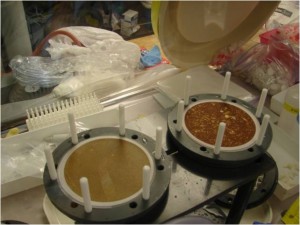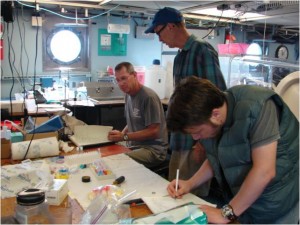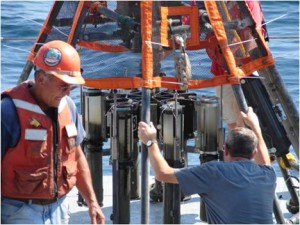Into the Dead Zone we go
 Before heading to bed last night, we were treated to seeing the first results of the In-Situ pump discs. As you can see on the photo to the left, there was quite a bit of content in the water column at our first station on the trip. The next step for Dr. Silke Severmann is to cut a small disc to determine exactly what was collected on those discs. From there, the remaining portions of the discs will be sliced up and divvied out to other interested parties for their individual studies. The lighter disc was from roughly 28 meters deep in the water column, while the darker red disc was from closer to the surface at about 10 meters. Look closely and you will see white splotches on the darker red disc, these unfortunate souls were the invertebrates that were pumped in along with the remaining elements in the water column, mainly thought to be jellies or possibly ctenophores. The amount of reddish color on the latter disc may be due to red algae or dinoflagellates, but that also has yet to be determined.
Before heading to bed last night, we were treated to seeing the first results of the In-Situ pump discs. As you can see on the photo to the left, there was quite a bit of content in the water column at our first station on the trip. The next step for Dr. Silke Severmann is to cut a small disc to determine exactly what was collected on those discs. From there, the remaining portions of the discs will be sliced up and divvied out to other interested parties for their individual studies. The lighter disc was from roughly 28 meters deep in the water column, while the darker red disc was from closer to the surface at about 10 meters. Look closely and you will see white splotches on the darker red disc, these unfortunate souls were the invertebrates that were pumped in along with the remaining elements in the water column, mainly thought to be jellies or possibly ctenophores. The amount of reddish color on the latter disc may be due to red algae or dinoflagellates, but that also has yet to be determined.
Dr. Will Berelson had a nice start to his morning, after a long night of data input and analysis. Bright and early, he took the time to share is data from the samples taken from the Lander, and things look good. Basically, the results showed what he hoped they would: as each of the samples  was taken at their specific time, the oxygen was depleted within that sample at a steady, consistent rate. Also, as the oxygen levels dropped off, the pH also was declining. He explained that this is the typical process in respiration: as oxygen is used, carbon dioxide is produced, which decreases the pH in a system. From the ampoules, other samples were fixed and are ready to be analyzed once back at the lab at the end of the cruise. There, they will be looking for various micro nutrients and trying to make the connections between oxygen rates and their presence.
was taken at their specific time, the oxygen was depleted within that sample at a steady, consistent rate. Also, as the oxygen levels dropped off, the pH also was declining. He explained that this is the typical process in respiration: as oxygen is used, carbon dioxide is produced, which decreases the pH in a system. From the ampoules, other samples were fixed and are ready to be analyzed once back at the lab at the end of the cruise. There, they will be looking for various micro nutrients and trying to make the connections between oxygen rates and their presence.
After yet another fabulous breakfast served up by Kim and Patrick, it was out and ready on the deck to deploy the CTD to determine Station #2’s water chemistry. The first samples came back a little short of the anticipated hypoxia. Fortunately, the most current Hypoxia Contours map was issued today by NOAA; this study is crucial to aiding all involved pinpoint pre-determined areas of hypoxia that are up-to-date. With all the fresh water events this year, mainly the flooding in the Mississippi, the data from last year is not as accurate for pinpointing coordinates of study. As soon as the second CTD was deployed about 5 nautical miles away from the first test, it confirmed what the new study was showing. Dr. McManus called it, met with the Captain and crew, and we were off to a new site as soon as the Multi-corer was finished procuring its samples and secured for moving.
Once we arrived about 4 hours NW of our first position, the CTD was readied and in the water. As soon as the results streamed in on the screens in the lab, Dr. McManus and all members of the science team were very happy with what they saw: oxygen levels near the bottom were 0.6 parts per million and lower. In fact we had to lower the range of the CTD data to micro mols/L of water to get more accurate readings.  We had reached our sight for study. There to greet us, and inspect just what we were up to, was a curious pod of Atlantic bottlenose dolphins. Just because the water is hypoxic, does not mean by any means it is devoid of life or activity.
We had reached our sight for study. There to greet us, and inspect just what we were up to, was a curious pod of Atlantic bottlenose dolphins. Just because the water is hypoxic, does not mean by any means it is devoid of life or activity.
 The remainder of the day’s light was spent collecting sediment samples with the multi-corer, water samples with the CTD, and last but not least the Lander was deployed in roughly 25 meters of established hypoxic water. Once the sediment samples were in, it was off to the cold room again to process the samples for later study. The lab is still very busy late in the evening, both with observations from today’s samples and in preparation for day two’s activities in at this station.
The remainder of the day’s light was spent collecting sediment samples with the multi-corer, water samples with the CTD, and last but not least the Lander was deployed in roughly 25 meters of established hypoxic water. Once the sediment samples were in, it was off to the cold room again to process the samples for later study. The lab is still very busy late in the evening, both with observations from today’s samples and in preparation for day two’s activities in at this station.
My absolute favorite part of this experience so far, is when we ask anyone on board, be it crew or scientist, a question related to their field and their eyes light up. Just talking with Dr. Berelson this morning, he would smile as he discussed the nature of the sampling and how the respiration process works. When you are surrounded with remarkable individuals such as this that are deeply passionate about what they do, it is hard not to get caught up in it. To dedicate your career, your life, to work like this you have to have that fire within for what you do. From the Captain to the Crew to the Research Assistants to the Lead Scientists, they all have that sincere love for what they do, and it is infectious.


 August 3, 2011
August 3, 2011 






Recent Comments